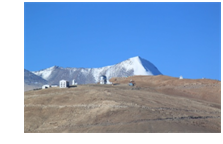ATRF-Aerosol-Cryosphere Interaction studies
1. The Himalayan Aerosol Observatory at Hanle

2. The chain of ARFI observatories over the Himalayas
- Recent field campaigns to the glaciers and long-term measurements from high altitude stations are used to understand the BC induced snow albedo forcing over southern slopes of Himalayas. Following a synthesis of measurements from the Himalayan ARFINET stations with those during a scouting experiment to a glacier, and models of snow and ice, coupled with radiative transfer schemes, this study highlighted the overwhelming role of snow-albedo forcing over direct forcing; the effect being higher for aged snow than for fresh snow. This has revealed a complex dependence of absorbing aerosols in the snow, the snow microphysics and other processes in determining the impact - the first major step towards understanding the aerosol-cryosphere interactions.
- A chain of observatories has been identified over the Himalayas to make extensive investigations on aerosol-cryosphere interaction processes using in-situ data collected through field experiments.
